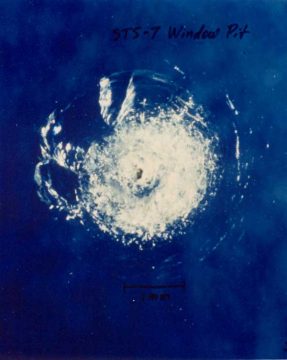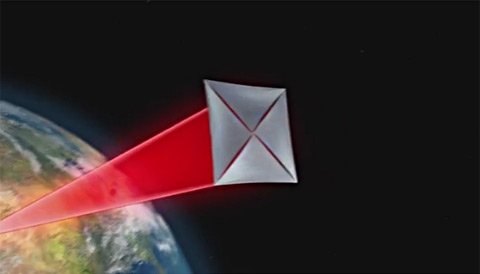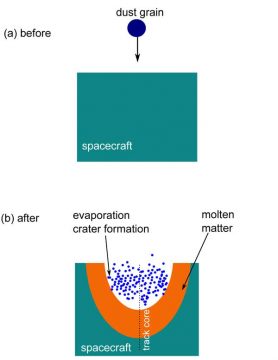Astronomy - Could Spacecraft Make it to Proxima Centauri?

A non-critical impact crater on one of the windows of the Space Shuttle Challengerfollowing a collision with a micrometeoroid during STS-7 in 1983.
NASA
NASA
Am I the only one who cringes every time Captain Kirk orders “Warp speed!” aboard theU.S.S. Enterprise? As the spaceship accelerates to the speed of light (and beyond, because, hey, it’s fiction), I can’t help but think: what if they run into something?
It wouldn’t take much. In 1983 a micrometeoroid collision cracked the window of the Space ShuttleChallenger, though the damage was non-critical.That was with the shuttle traveling at an orbital speed of only 18,000 mph, nine times the speed of an average rifle bullet — but only 0.0027% the speed of light.
If we ever want to travel at truly relativistic speeds to reach the nearest stars, spacecraft will have to endure far more — and the planet discovered around Proxima Centauri makes the prospect of interstellar travel awfully tempting.
The Breakthrough Starshot initiative intends to do just that. Last April, billionaire Yuri Milner announced he was putting $100 million on the table to fund scientists and engineers to test the feasibility of sending gram-scale spacecraft on a 20-year journey to the Alpha Centauri system at 20% the speed of light.
At one-fifth lightspeed, even micron-size dust grains gas atoms between stars pose a real threat, one that’s listed among the initiative’s challenges. But how much of a threat? That’s the question Thiem Hoang (University of Toronto) and colleagues set out to answer. (Full disclosure: two of the four coauthors help lead the Breakthrough Starshot initiative.)
Traveling through the Interstellar Medium

Breakthrough Starshot, Russian billionaire Yuri Milner's latest project, aims to use light sails to laser-boost tiny probes to 20% the speed of light. They're supposed to report back from other stars.
In a paper posted August 18th to the online preprint server arXiv.org Hoang’s team explored what might happen to a tiny, gram-scale probe like that proposed by Breakthrough Starshot: a mini spaceship made of a computer chip that contains the all-important sensors (composed primarily of silica) and a reflective lightsail vital to accelerating the craft (composed of graphite).
Because of the probe’s high speed, it essentially sees any lone atom or dust mote floating in space as a relativistic projectile. Dust is the main enemy. While interstellar gas is mostly hydrogen and helium, with a few other trace elements thrown into the mix, cosmic dust particles, while tiny and rare, are composed mostly of heavier atoms. At relativistic speeds, every dust grain that gets in the way will both evaporate and melt material on the spacecraft, generating an impact crater.
If the dust grain is any bigger than 15 microns (roughly the width of a human hair), the crater it makes will encompass a gram-scale spacecraft — in other words, a single “large” dust grain would destroy the whole probe! Fortunately, cosmic dust grains of this size are rare: the authors peg the chance of running into one of them at one in 1050 (that’s one in a trillion trillion trillion or so, or in other words, practically never). Still, impacts from smaller grains could be enough to damage sensors or other key components.
Though dust can wreak havoc, interstellar gas shouldn’t be ignored, the team found. The few heavy atoms in the diffuse gas between stars can do their share of damage. They’re particularly dangerous to silica-based materials (not so much to the graphite-based lightsail), leaving tracks of damaged in their wake that gradually weaken its strength.
Incorporating all of these effects, Hoang and colleagues calculated how deeply interstellar gas and dust could erode the surface of a thin, rectangular probe:
| QUARTZ | GRAPHITE | |
|---|---|---|
| Interstellar gas | 0.1 mm | 0.01 mm |
| Interstellar dust (evaporation) | 0.5 mm | 0.5 mm |
| Interstellar dust (melting) | 3 mm | 1 mm |
The numbers are in line with lab experiments that have shot energetic particles at matter, though more data is still needed to test how high-speed dust molecules would interact a solid surface.
Shields Up, Mr. Sulu!

If a probe hits a dust grain at relativistic speeds, the spot of impact heats up and evaporates (close to the dust grain) and melts (farther from the grain), creating a crater on the surface of the quartz or graphite material.
Hoang et al., arXiv.org
Hoang et al., arXiv.org
So, how does one protect a spacecraft traveling at a significant fraction of lightspeed? Hoang and colleagues suggest two complementary approaches. One is to make the spacecraft long and slim, like a needle: the less surface area the spacecraft presents to the onslaught of interstellar debris, the less damage it’ll take — especially from cosmic dust. (The concept is similar to the aerodynamic design of cars and airplanes, though for entirely different reasons.)
The second approach is to shield the probe with some kind of protective covering, such as a graphite coating a few millimeters deep. The lightsail itself — which is really only necessary for acceleration — could provide additional shielding, the authors suggest, if it’s folded up in front of the sensor-laden chip once the probe is underway.
So an interstellar flight to Proxima Centauri might well be feasible. And flying out of the solar system isn’t a problem because the Alpha Centauri system lies out of the ecliptic plane. The caveat, says coauthor Abraham Loeb (Harvard University), is that we know very little about how the level of dust rises near the star — we don’t even know how “edge-on” we’re seeing Proxima Centauri. “There is a risk that if its dust content is much larger than that of the solar system, it will damage the spacecraft,” Loeb explains.
Loeb chairs Breakthrough Starshot’s advisory board, which just convened this week to organize the initiative’s first five to ten years. During this first phase, scientists and engineers will test the feasibility of travel to the nearest star system. The recent discovery of an exoplanet around Proxima Centauri, Loeb adds, provides an obvious target for a flyby mission — and a sense of urgency for seeing results within our lifetimes.
No comments:
Post a Comment